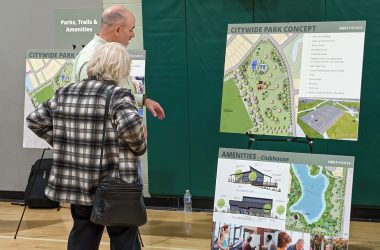The city of Banks plans to conduct a feasibility study to provide the Banks City Council with a cost analysis for removing utility poles on Main Street and submerging those power lines underground.
City Manager Jolynn Becker said the possibility of the city upgrading its aging infrastructure along Main Street is both for efficiency and improved reliability, especially during intense storms, and for the beautification of downtown Banks.
“One of the goals in our plans to beautify Main Street is to make the sidewalks walkable and (the area) more attractive,” Becker said. “But (the city council) has to first decide if we are ready to move forward with undergrounding and if we have the funding to do this.”
During the June city council work session, Becker explained that she met with Portland General Electric (PGE) officials who explained it offers two options for generating revenue to pay for the undergrounding of utility lines — methods it calls “force” and “conversion.”
With “force,” PGE runs the project and the city of Banks would be required to establish a repayment zone that includes either all utility customers inside the Banks’ city limits or just a section of town that would first be determined by the city council.
Becker said PGE couldn’t guarantee it would be able to underground any utility poles taking this approach until a thorough examination of existing infrastructure takes place.
“It establishes a ‘payback’ because (PGE) would charge back that work to the residents and it would be added to their bill,” Becker said. “You could be looking at (charges ranging from) $35 to $100 that would be added to someone’s PGE bill based on the cost of the project,”
The second method is known as “conversion.” Taking this approach, the city would cover the cost of the project and it would need to get property owners to buy in and agree to allow the work to be done on their land, she said.
“Based on these reasons, I would recommend holding off and not going forward because with the cost on ‘conversion’ you don’t know if it’s going to come in at $400,000 or $1 million because they would have to create the building plan and there would be costs associated with that,” Becker said. “They might need to buy an easement into someone’s property for trenching” but there is no guarantee any property owners would agree to this.
Becker advised the council to instruct city staff to conduct a feasibility study that looks into all of the available options so that all potentially-involved parties – the city, PGE, and ratepayers – can meet and try to find an amicable solution.
City Attorney Dan Kearns told the council that in his experience working with other municipalities or jurisdictions, a city could require utility lines to be undergrounded but it is a “stunningly expensive” endeavor based on the cost of the amortized lifetime value of the existing utility poles.
“The pushback I’ve gotten before (from utility companies) is, ‘We’ll do it and we don’t charge the city but we will charge the city’s rate base,’” he said. “It has to be paid for by someone other than the company.
The rate base of the entire state would not benefit from the aesthetic qualities the city of Banks is trying to achieve, so local utility customers would pay the cost, and that cost would be spread over a surprisingly short period of time – just a few years. Monthly bills for three to five years could be $50 to $100 extra per month per customer, Kearns said.
“For your policy priorities going forward – I think you’re looking at some substantial subdivisions being constructed here in the next 10 years and certainly you should have all of those built with underground utilities,” Kearns said. “The cost question for (the city of Banks) over that 10-year period is if you want to achieve this policy (of beautifying) Main Street how is it going to be paid for or how can you get as much as you can undergrounding where it matters most.”
Becker added that PGE officials said the company hasn’t taken the “force” approach in Oregon in 40 years but that it has completed projects using the “conversion” method of recouping costs.
Mayor Stephanie Jones said it was her understanding that many of the older homes and commercial buildings on Main Street are old enough that they can only be connected to above-ground utility lines.
“That’s why I’m suggesting we do a feasibility study to identify what will be required if it happened and if it did what we would require on Main Street and what we can and can’t do so that we can make a proper decision about redoing Main Street at a later date” without outside funding,” Becker said.






